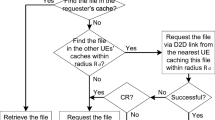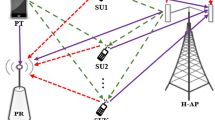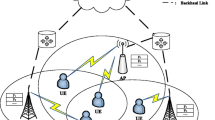Abstract
Edge caching has received much attention as a promising technique to overcome the stringent latency and data-hungry challenges in the future generation wireless networks. Meanwhile, full-duplex (FD) transmission can potentially double the spectral efficiency by allowing a node to receive and transmit at the same frequency band simultaneously. In this paper, we investigate the delivery time performance of a cache-aided FD system, in which an edge node, operates in FD mode, serves users via wireless channels and is equipped with a cache memory. Firstly, we derive a closed-form expression for the average delivery time by taking into account the uncertainties of both backhaul and access wireless channels. The derived analysis allows the examination of the impact of key parameters, e.g., cache size and transmit power. Secondly, a power optimization problem is formulated to minimize the average delivery time. To deal with the non-convexity of the formulated problem, we propose an iterative optimization algorithm based on the bisection method. Finally, numerical results are presented to demonstrate the effectiveness of the proposed algorithm. A significant delivery time reduction is achieved by the proposed optimization compared to the FD reference and half-duplex counterpart.





Similar content being viewed by others
Notes
Considering a random model of \(\eta\) is left for future work.
The computation time is assumed to be negligible.
References
Borst, S., Gupta, V., & Walid, A. (2010). Distributed caching algorithms for content distribution networks. In Proceedings of IEEE international conference on computing and communication (pp. 1–9).
Gabry, F., Bioglio, V., & Land, I. (2016). On energy-efficient edge caching in heterogeneous networks. IEEE Journal on Selected Areas in Communications, 34(12), 3288–3298.
Vu, T. X., Chatzinotas, S., & Ottersten, B. (2018). Edge-caching wireless networks: Performance analysis and optimization. IEEE Transactions on Wireless Communications, 17(4), 2827–2839.
Ji, M., Caire, G., & Molisch, A. F. (2016). Wireless device-to-device caching networks: Basic principles and system performance. IEEE Journal on Selected Areas in Communications, 34(1), 176–189.
Xu, F., Tao, M., & Liu, K. (2017). Fundamental tradeoff between storage and latency in cache-aided wireless interference networks. IEEE Transactions on Information Theory, 63(11), 7464–7491.
Yang, L., Chen, Y., Li, L., & Jiang, H. (2019). Cooperative caching and delivery algorithm based on content access patterns at network edge. Wireless Networks,. https://doi.org/10.1007/s11276-019-02148-7.
Ren, J., Hou, T., Wang, H., Ren, H., & Zhang, X. (2019). Increasing network throughput based on dynamic caching policy at wireless access points. Wireless Networks,. https://doi.org/10.1007/s11276-019-02125-0.
Vu, T. X., Chatzinotas, S., Ottersten, B., & Trinh, A. V. (2020). Full-duplex enabled mobile edge caching: From distributed to cooperative caching. IEEE Transactions on Wireless Communications, 19(2), 1141–1153.
Khreishah, A., Chakareski, J., & Gharaibeh, A. (2016). Joint caching, routing, and channel assignment for collaborative small-cell cellular networks. IEEE Journal on Selected Areas in Communications, 34(8), 2275–2284.
Ozfatura, M. E., ElAzzouni, S., Ercetin, O., & ElBatt, T. (2019). Optimal throughput performance in full-duplex relay assisted cognitive networks. Wireless Networks, 25(4), 1931–1947. https://doi.org/10.1007/s11276-018-1692-5. [Online].
Chen, L., Yu, F. R., Ji, H., Rong, B., & Leung, V. C. M. (2018). Power allocation in small cell networks with full-duplex self-backhauls and massive mimo. Wireless Networks, 24(4), 1083–1098. https://doi.org/10.1007/s11276-016-1381-1. [Online].
Sabharwal, A., Schniter, P., Guo, D., Bliss, D. W., Rangarajan, S., & Wichman, R. (2014). In-band full-duplex wireless: Challenges and opportunities. IEEE Journal on Selected Areas in Communications, 32(3), 1637–1652.
Maso, M., Atzeni, I., Ghamnia, I., Baştuğ, E. & Debbah, M. (2017). Cache-aided full-duplex small cells. In 15th International Symposium on modeling and optimization in mobile, Ad Hoc, and wireless network (WiOpt) (pp. 1–6).
Naslcheraghi, M., Afshang, M., & Dhillon, H. S. (2018). Modeling and performance analysis of full-duplex communications in cache-enabled d2d networks. In IEEE international conference communications (pp. 1–6).
Hemachandra, K. T., Ochia, O., & Fapojuwo, A. O. (2018). Performance study on cache enabled full-duplex device-to-device networks. In IEEE wireless communication networks and conference (pp. 1–6).
Vu, T. X., Lei, L., Chatzinotas, S., Ottersten, B., & Trinh, A. V. (2019). On the successful delivery probability of full-duplex enabled mobile edge caching. IEEE Communications Letters, 23(6), 1016–1020.
Kakar, J., Alameer, A., Chaaban, A., Sezgin, A., & Paulraj, A. (2018). Delivery time minimization in edge caching: synergistic benefits of subspace alignment and zero forcing. In Proceedings of IEEE international conference on communications (pp. 1–6).
Knox, M. E. (2012). Single antenna full duplex communications using a common carrier. In WAMICON 2012 IEEE wireless microwave technology conference (pp. 1–6).
Bharadia, D., & Katti, S. (2014). Full duplex mimo radios. In Proceedings of 11th USENIX conference on network and system design and implementation, Ser. NSDI’14, No. 14 (pp. 359–372). Berkeley, CA: USENIX Association.
Hamid, M., & Kostanic, I. (2013). Path loss models for LTE and LTE-A relay stations. Universal Journal of Communications and Network, 1(4), 119–126.
Acknowledgements
This work is supported by the Luxembourg National Research Fund under the project FNR CORE ProCAST, and by the European Research Council under project AGNOSTIC.
Author information
Authors and Affiliations
Corresponding author
Additional information
Publisher's Note
Springer Nature remains neutral with regard to jurisdictional claims in published maps and institutional affiliations.
Rights and permissions
About this article
Cite this article
Vu, T.X., Trinh, A.V., Chatzinotas, S. et al. Cache-aided full-duplex: delivery time analysis and optimization. Wireless Netw 26, 4403–4410 (2020). https://doi.org/10.1007/s11276-020-02334-y
Published:
Issue Date:
DOI: https://doi.org/10.1007/s11276-020-02334-y




